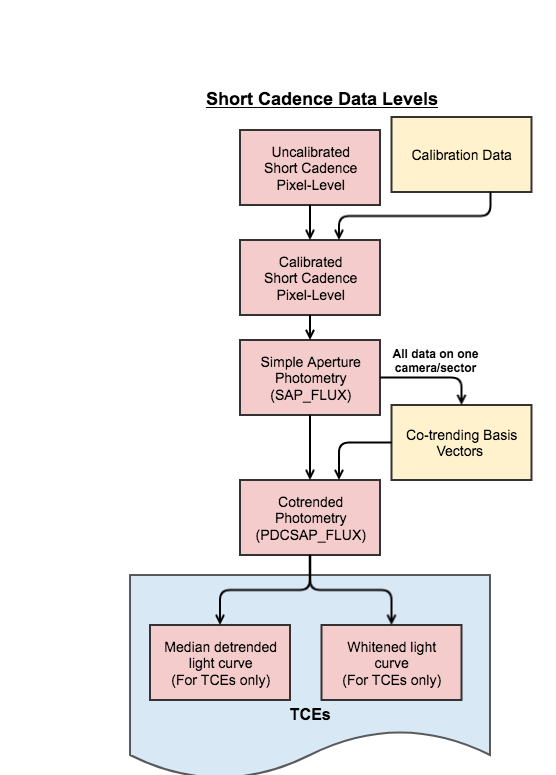TESS provides several levels of data processing for their time series photometry. Users should chose which they desire depending on their scientific needs. Here we describe the photometry from the lowest level of processing to the highest level, which is intended to be used for planet searches.

Time Series Images
- Full frame images are available at a 30-minute cadence in both their uncalibrated and calibrated forms.
- Postage stamp cutouts of portions of the detector at a 2-minute cadence are available in the target pixel files. Both the uncalibrated and calibrated pixels are available.
Short Cadence Light Curves
- Simple Aperture Photometry (SAP_FLUX in light curve files) light curves are available for the short cadence targets. These are produced by summing the flux in specified apertures around the specified stars and correcting for known light from other stars using the TIC.
- Systematics removed (PDCSAP_FLUX in light curve files) light curve are produced by the Presearch Data Conditioning (PDC) algorithm of the TESS pipeline. The intent is to remove common systematics across each CCD, leaving behind the astrophysical signals. The algorithm uses the co-trending basis vectors an baysian priors to determine what signals to remove from the original light curves. This method of detrending is not optimal for all types of science and so users should evaluate its effectiveness (Smith et al. 2012).
- Do-It-Yourself systemtics removed light curves are available using a byproduct of the PDC algorithm. PDC produces basis vectors that can be fit and removed from the time-series. Tools are available to allow users to adjust which basis vectors they want to fit and remove from the data to create their own custom co-trended light curve similar to that provided by the pipeline. <A link to such a tool would be nice here>
- Median Detrended, harmonics removed, outlier removed light curves are produced by the Data Validation (DV) module of the TESS pipeline. Here the intent is to remove all signals besides those of exoplanets.
- Whitened, harmonics removed, outlier removed light curves produced by the Data Validation (DV) module of the TESS pipeline. Here the intent is to create a light curve that can easily be searched using a wavelet-based adaptive matched filter (Jenkins et al. 2018). However astrophysical signals, including transits, get distorted in this process, and so users need to be careful not to over-interpret these time series.
Long Cadence Light Curves
We highly expect long cadence light curves will be created and delivered, but currently there are not definitive plans that can be mentioned here.
